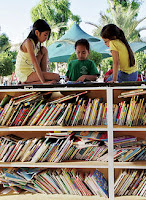Israel is comprised of many different religions and cultures. One of the populations that I was totally unfamiliar with are the "Druze". Primarily found in the northern area of Israel, the Druze people are a separate monotheistic religion - distinct from Judaism, Christianity, and Islam. The Druze religion is a very private religion and is closed to converts. The worldwide population is estimated somewhere between 1 and 2.5 million, of which 100,000 live in Israel.
From what I understand, during the 1948 War of Independence, the Druze actually fought alongside of the Jews against the invading Arab countries. To this day, the Druze continue to serve in the Israel military. One thing I find especially interesting about the Druze is their attitudes towards women. Apparently they have the ability to attain high rank in their religion. Women are even seen as being better "spiritually prepared" than men. In everyday life, the rights of the women is almost identical to men. In the Middle East, there are so many cultures that treat their women as second-class citizens - I am so glad the Druze aren't one of them!
There are several Druze villages that are noted for their great hospitality to visitors. One such place is Daliyat el-Carmel, a village located on the slopes of Mt. Carmel in Northern Israel. This Druze village hosts markets on Saturdays and many of the village shops offer ethnic foods such as: olive oil, olives, pita bread, and cheese. Other sites in the village include olive oil presses, textile workshops, and art galleries. There is even a Druze heritage house that offers an exhibit on the lifestyle of the Druze people.
In some of the Druze villages, visitors are welcomed into their home for lunch. These intimate gatherings allow people to see how the Druze live, what foods they eat, and learn more about their culture. I don't know if you have to be part of an organized group to participate in these in-home visits? However, if I had the opportunity to visit on my own, I would. I think that the more we can learn about other cultures - the smaller the world becomes.
From what I understand, during the 1948 War of Independence, the Druze actually fought alongside of the Jews against the invading Arab countries. To this day, the Druze continue to serve in the Israel military. One thing I find especially interesting about the Druze is their attitudes towards women. Apparently they have the ability to attain high rank in their religion. Women are even seen as being better "spiritually prepared" than men. In everyday life, the rights of the women is almost identical to men. In the Middle East, there are so many cultures that treat their women as second-class citizens - I am so glad the Druze aren't one of them!
There are several Druze villages that are noted for their great hospitality to visitors. One such place is Daliyat el-Carmel, a village located on the slopes of Mt. Carmel in Northern Israel. This Druze village hosts markets on Saturdays and many of the village shops offer ethnic foods such as: olive oil, olives, pita bread, and cheese. Other sites in the village include olive oil presses, textile workshops, and art galleries. There is even a Druze heritage house that offers an exhibit on the lifestyle of the Druze people.
In some of the Druze villages, visitors are welcomed into their home for lunch. These intimate gatherings allow people to see how the Druze live, what foods they eat, and learn more about their culture. I don't know if you have to be part of an organized group to participate in these in-home visits? However, if I had the opportunity to visit on my own, I would. I think that the more we can learn about other cultures - the smaller the world becomes.









































